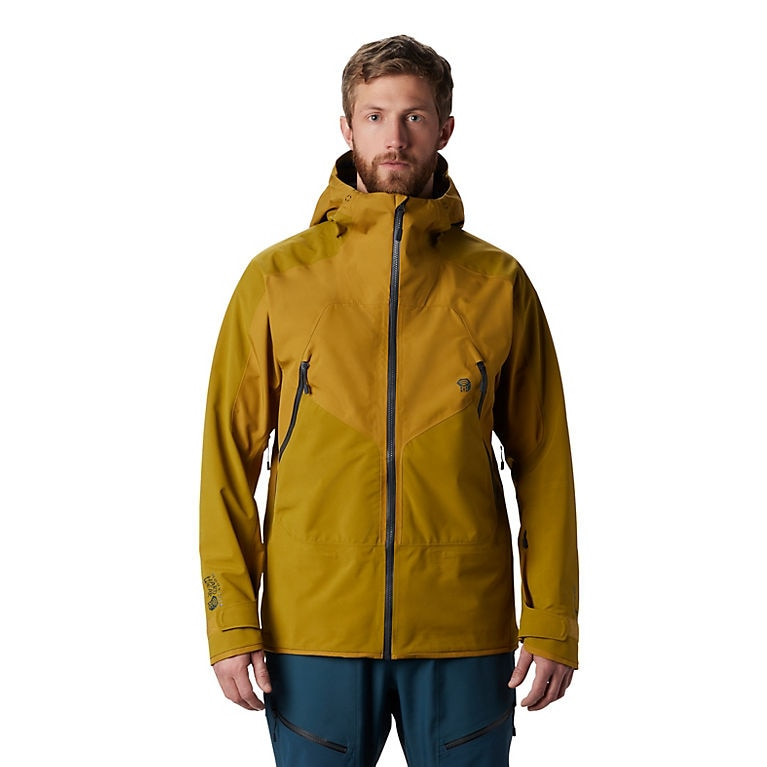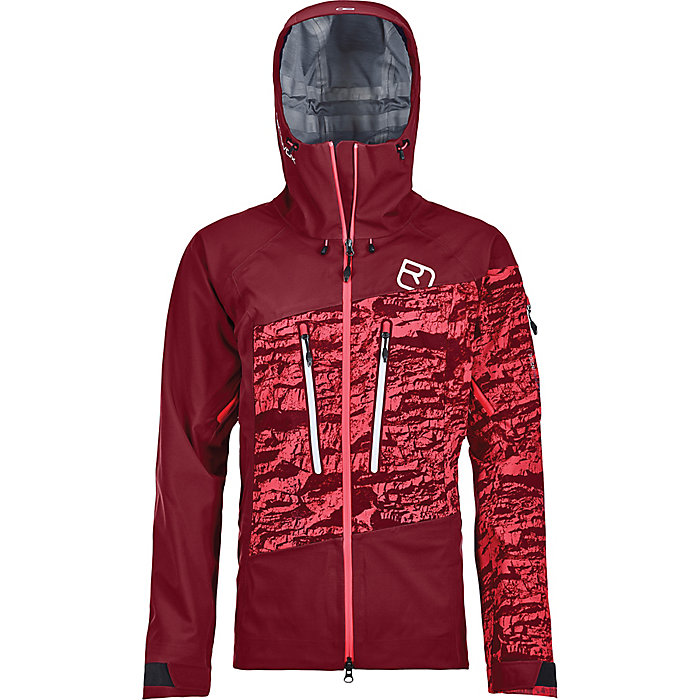



The hard shell jacket is the ultimate outer layer for skiers and snowboarders. In this Active Junky Buyer’s Guide, we’ll discuss why hard shell jackets are essential for skiing, snowboarding, and backcountry touring. We’ll also break down a few key considerations to keep in mind when shopping for a hard shell jacket. Finally, we’ll dive into reviews of some of the best men’s and women’s hard shell jackets from top brands like The North Face, Mammut, Ortovox, Mountain Hardwear, Outdoor Research, and Picture Organic.
Hard Shell Jacket 101
What is a hard shell jacket and why do I need one?
If you’re familiar with the benefits of hard shell jackets and want to get straight to the gear, feel free to skip down to the reviews of the best hard shell jackets of 2020. Otherwise, stick around for a little Shell Jacket 101.
A shell jacket is basically your outer layer of defense. A shell is, by definition, a lightweight jacket devoid of insulation. While puffy jackets are meant to insulate you from the cold, a shell’s job is to defend you from the wet and the wind. Rain jackets fall into this category, as do windbreakers. Unsurprisingly, “shell” is a broad umbrella term that can refer to any number of uninsulated outer layers.
Given that we’re getting into the thick of ski season, we’ve focused this Buyer’s Guide on ski shells—hard shells that are designed to be worn while skiing in and out of the resort. Since they need to withstand wintery conditions, ski shells tend to be much more rugged than rain jackets and windbreakers. Because skiers and snowboarders are pushing their physical limits, their shells need to allow full range movement and also be crafted from a waterproof, breathable material. Lastly, skiers and snowboarders will gravitate towards hard shells with purpose-built, ski-friendly features like helmet-compatible hoods, powder skirts, pit zips, and more.
That said, keep the following in mind: some of these hard shells come in handy during other activities like backpacking, mountaineering, mountain biking, hiking, and more.

What’s the difference between hard shells and soft shells?
In this Buyer’s Guide, we’re focusing on hard shells rather than soft shells. These terms come up often, and it’s important to know the difference between them. The primary distinction is that hard shells are waterproof, while soft shells are not. Soft shells are subsequently more breathable and are occasionally preferable to hard shells when taking on a high-output activity like ice-climbing, mountaineering, or backcountry skiing. If you are just going to buy one shell for skiing, you 100% want to get a hard shell, because it’s much more versatile and can handle violent weather, whereas a soft shell is more of a specialized piece of gear that doesn’t do well in extreme precipitation.
Why is a hard shell such an essential piece of the layering puzzle?
To the untrained eye, a hard shell’s lack of insulation might be construed as a negative. You might be asking yourself, “Why would I buy an uninsulated shell when it’s less warm and more expensive than an insulated ski jacket?”
To the savvy skier or snowboarder, though, a hard shell is preferable to an insulated outer layer because it is so much more versatile. Why? Because you can pair a hard shell with various breathable base layers and insulated mid-layers in order to adapt to any situation. For instance, let’s say you’re hiking in-bounds terrain at your favorite ski resort or skinning up a mountain in the backcountry. You’re guaranteed to overheat in a traditional insulated jacket, but by layering a shell over an insulated mid-layer, you’re more prepared to adapt. When you start to warm up, you can shed your mid-layer, throw your shell jacket back on, and keep chugging without sweating up a storm.
What’s more, you can also adapt as conditions change throughout the season. On the coldest days, you can stack warmer layers underneath your hard shell. On warm spring days, you can forgo a mid-layer altogether. In both of those extreme cases, you can rely on the exact same shell jacket. In the long run, then, purchasing a high-quality shell is actually a smart investment.
Bottom line? Whether you’re skier, a backcountry traveler, or you dabble both in-bounds and out, a waterproof, breathable hard shell jacket is an absolute essential.

If you’re shopping for a ski-friendly hard shell in 2020, it can be overwhelming: there are a ton of options and it’s easy to get lost in the flood of marketing lingo. Luckily, you’re in the right place. Our team of five skiers and snowboarders put the following shells to the test early this winter in California, Utah, and Wyoming, and we’ve picked out a few of our favorite ski shells to keep you dry, shredding, and stoked when you’re on the hill. Read on to get a feel for our top picks and keep scrolling to check out the full reviews.
Best Lightweight Shell: Outdoor Research Interstellar Shell
The Interstellar Shell isn’t exclusively a ski shell—you can rock this thing while mountain biking, climbing, and more. While it isn’t the most durable of shells, it is insanely lightweight, notably versatile, and our go-to for fast and light missions due to its low weight and minimal volume.
Best Men’s Midweight Shell: Ortovox Ortler Jacket
For everyday use in the backcountry, it’s hard to beat the Ortler. This shell is true to Ortovox’s Euro roots both in terms of style and the fact that it’s capable in mixed alpine conditions.
Best Men’s Heavyweight Shell: Mountain Hardwear Boundary Ridge Shell
For skiers who prize protection against the elements, the Boundary Ridge is a stalwart outer layer. It’s not the most packable shell, making it more tuned to sidecountry exploration and deep resort days than full-on backcountry expeditions.
Best Sustainable Shell: Picture Organic Harvest Shell
Picture Organic is changing the outerwear game with their Harvest Shell. Not only does this kit look stylish, but it’s also equipped with a sustainable waterproof membrane derived from castor oil.
Best Midweight Women’s Shell: Mammut Haldigrat
A mid-range women’s shell that’s primed for backcountry skiing, the Haldigrat gives you everything you need with nothing you don’t.
Best Freeride Women’s Shell: Ortovox 3L Guardian
The Guardian has a merino liner that’s soft against the skin, but the hard shell’s exterior is still hardy enough to take on the toughest freeride conditions.
Best Freeride Men’s Shell: The North Face A-CAD
The feature-rich, FUTURELIGHT-equipped A-CAD has ample pockets, a baggier fit, and rock-solid powder skirt, making it a favorite for deep days. It’s also the best-looking men’s jacket we tested—and style counts when it comes to freeriding.

Pros:
The Interstellar Shell is the lightest shell that we’ve tested. Unsurprisingly, it’s also the most packable. These pros are major, and for backcountry skiers who are extremely conscious about the weight and volume of their kit, this shell is an excellent choice.
Cons:
Due to the thin fabric, the Interstellar is not the most durable of shells in this Buyer’s Guide. While we’ve yet to put a hole in it over the past two months of testing, durability is certainly a concern. Also, the Interstellar waterproof rating is only 15,000mm—many of the other shells in this buyer’s guide are rated to 20,000mm or even higher. It will get the job done in run-of-the-mill snow storms, but in wet snow or thick rain it is prone to fail. Also, there are no pit zips (although the fabric is extremely breathable and you likely won’t need underarm vents).
Favorite Feature:
Outdoor Research’s adventure-fueled R&D led to the creation of their AscentShell technology, which essentially uses an electrospinning process to craft a fabric that is both breathable and waterproof. Breathable and waterproof is the basic recipe for any decent shell, but where the AscentShell fabric truly wins is the stretch and weight—the Interstellar is extremely stretchy and weighs next to nothing (11.8 ounces, as measured by OR).
Tester Comment:
“I keep thinking that outdoor companies have reached a ceiling when it comes to shaving weight—the Interstellar shatters that ceiling. At 11.8 ounces, this jacket is perfect for stashing in your pack while ski touring or splitboarding. It’s not ever going to be something I wear to the resort, but for backcountry and adventure travel, it’s my new go-to.”
Bottom Line:
While the Interstellar isn’t the most waterproof or durable of shells, it is the lightest. And for some backcountry skiers and splitboarders, that makes all the difference.
Pros:
Ortovox’s 3L Ortler Jacket is primed for missions into the high-alpine. The 3-layer fabric is lined with a DERMIZAX®NX membrane, which boasts a high waterproof rating (20,000mm minimum). The durable, rugged outer material won’t be compromised by backcountry bushwhacking. While the fabric itself was a huge plus in the eyes of one tester, he was also smitten with the slim-fitting cut of the shell, as well as the helmet-compatible hood, easy-to-operate pit zips, and secure cuffs. Finally, we’re also big fans of the design: the asymmetric block print stands out from the pack without being excessively gaudy.
Cons:
There’s little in the way of pocket space, as the Ortler Shell is purpose-built for use with a backpack. For resort riders, this may be a deal-breaker, but it’s par for the course in the backcountry realm.
Favorite Feature:
Pit zips are a favorite for anyone who is climbing mountains and skiing down ‘em. Ortovox’s are stress-free to manage even with gloves on.
Tester Comment:
“I love the durability of this waterproof shell—it’s confidence-inspiring when out in the backcountry. And the block print looks rad, too!”
Bottom Line: For skiers, splitboarders, and alpinists who want an everyday shell that can handle any and all conditions, the lightweight Ortovox Ortler is an intelligently designed, well-balanced essential.

Pros:
The Mountain Hardwear Boundary Ridge GORE-TEX Jacket is built to withstand more than the elements. In addition to snow storms and face shots, this shell can handle dense willows, crampon spikes, ice ax adzes, and spilled après beers. Hands down, this was the toughest shell of the test.
The waterproof, breathable GORE-TEX 3L fabric is durable on its own, but Mountain Hardwear bolstered the Boundary Ridge Shell with reinforced sections at critical zones along the torso, arms, and hood. The resulting shell is borderline bombproof and effective in everything but the most obscenely inclement climes. MH maintained that “tough” theme throughout the build of the Boundary Ridge, equipping the shell with a burly powder skirt, oversized zippers, ample pocket space, and a heavy-duty hood.
Cons:
As is to be expected, extreme durability comes at the cost of added weight. One of the heavier shells we tested, the Boundary Ridge is not ideal for those skiers and riders who spend most of their time outside of the resort.
Favorite Feature:
If you do hit the backcountry or duck out of a sidecountry gate, the chest pockets are sizeable enough to stash climbing skins.
Tester Comment:
“Though not my first choice for backcountry missions due to the weight, this is my top pick for longevity. Given the reinforced fabric and brawny build, I expect this jacket to outlast many of the other shells that I’ve tested.”
Bottom Line:
For skiers and riders who live for bottomless days at the resort—and occasionally tour to get the goods—this heavyweight shell is reliable, durable, and seriously waterproof.

Pros:
Few ski companies are as committed to an environmental mission as Picture Organic. Case in point: their new Harvest Jacket. This award-winning jacket follows the same recipe as typical high-performance shells: it has a 3-layer build, taped seams, burly zippers, and a freeride fit. The difference, in this case, comes down to the ingredients themselves.
The Dryplay Biosource Membrane meets the highest waterproof ratings (20,000mm) that hardcore skiers require, but it’s like nothing else on the market. In fact, Dryplay is derived from castor oil, a renewable resource. What’s more, the Harvest Jacket is also crafted from a fabric blend that includes 58% recycled polyester.
Of course, a sustainable storyline isn’t enough to meet the on-mountain needs of resort and backcountry skiers, but luckily Picture delivers on all fronts with the Harvest Jacket. The shell proved itself in-bounds and out to our test team, and testers dug the robust zippers and spacious pockets. The snow skirt, wrist gaiters, and adjustable hood solidified the stretchy yet waterproof shell as a top pick for deeper days.
Cons:
The fit is a tad on the Euro end of the spectrum, so those looking for a particularly roomy cut will want to size up.
Favorite Feature:
We dug the pit vents and knit section on the back—this combo offers excellent ventilation and lets the Harvest breathe on the uphills.
Tester Comment:
“When sustainable gear performs as good (or better) than its non-renewable competition, it’s a no-brainer: the snowsports community should rally around those products. I heartily recommend that skiers and riders consider the Harvest—not only is it a step in the right direction as far as ethical manufacturing, but it’s also a badass shell that can handle anything you can.”
Bottom Line:
Skiers and snowboarders who love winter—and want to keep enjoying winter for decades to come—should check out this eco-friendly, game-changing shell.

Pros:
From the jump, our tester judged that the slightly tapered fit of the Haldigrat is comfortable and looks fresh on the skintrack. Additional backcountry-friendly features—the removable powder skirt, stretchy wrist gaiters, double-zipper pit vents, and backpack-compatible pockets—ensure that the Haldigrat doesn’t just look good on the uphill, but it performs well, too.
Cons:
Our tester has powerful legs and wide hips, and she noticed that the powder skirt can ride up a little bit, despite the elastic band.
Favorite Feature:
The Single Pull hood is easily adjustable and can be used with or without a helmet.
Tester Comment:
“I love this jacket. I’ve had jackets with hoods that fly back in the snow, rain, and wind, but this hood was big enough where it fully covered my head and helmet, was easy to cinch down, and protected my forehead with the built-in hard visor.”
Bottom Line:
For lady shredders who spend their days both in and out of the resort, Mammut’s Haldigrat is a jack(et) of all trades.

Pros:
Merino, merino, merino. With a thin liner of silky-smooth merino wool gracing the inside of this waterproof 3-layer jacket, the Guardian is actually incredibly comfortable against the skin—an accolade that few shells can boast. When spring comes around and you’re skiing in a t-shirt, a shell, and nothing else, that merino liner is a dream come true. Even in mid-winter, the merino-lined Guardian makes for a quality companion. Our tester noted that the merino helped to wick away sweat and keep her dry. She also noted that the merino-lined pockets kept her phone alive and well in blustery conditions. Lastly, she appreciated the ergonomic design of the pockets, the spacious, helmet-compatible hood, and the warmth provided by the high neck cuff.
Cons:
While lightweight for a freeride shell, the Guardian isn’t very packable for backcountry travelers. Our tester also noted that the high neck cuff made eating and drinking difficult. Lastly, this bold graphic style may be too much for some skiers who like to keep a low profile.
Favorite Feature:
Did somebody say merino?
Tester Comment:
“While the Guardian definitely was designed to wear in the resort setting, it was breathable enough and had enough vents that it would work for the skier or rider who gets out touring a few times a year but doesn't want to buy a whole new set up. Kind of like the one-jacket quiver.”
Bottom Line:
A one-jacket quiver for freeriders, this merino-lined shell is as comfortable as it is capable.

Pros:
When The North Face announced their ground-breaking FUTURELIGHT tech, they threatened to rip the rug out from under the apparel industry. Essentially, FUTURELIGHT is a nano-spun material that’s peppered with purposefully tiny holes through which air can pass but water drops cannot. FUTURELIGHT is waterproof, breathable, and has to make The North Face’s old partner’s at W.L. Gore & Associates exceedingly nervous.
The hype, in the case of FUTURELIGHT, is real: we tested the A-CAD in subzero temperatures in Utah and were impressed by the performance. Despite the material being so thin and light, it cut the wind beautifully. The fit is freeride-friendly: it’s big without being too baggy. Style-wise, the A-CAD was arguably the best-looking shell of the bunch. It certainly earned the most compliments due to the two-tone coloring, bold zipper lines, and loose fit.
Cons:
We were impressed by the potential of the FUTURELIGHT material, however, this jacket is far from a featherweight. Weighing just over 2 lbs, this shell is heavy and best-suited for in-bounds riding, heli drops, cat days, or sidecountry jaunts.
Favorite Feature: Our tester was amped on the pockets of the A-CAD. The large chest pockets hold plenty of snacks, and the lower front pockets are big enough to hold mittens, spare lenses, or other essentials.
Tester Comment: “I recently wore it in -8-degree weather with 50-mph wind gusts and while everyone else was complaining about the cold, I was raving about how great the powder was! The only thing I will warn people about is the fact that the sizing runs large.”
Bottom Line:
A sharp-looking shell with best-in-class pockets, the A-CAD gives freeriders space for all their snacks. Look good, eat good, shred better.